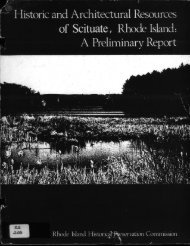national register of historic places registration form - Rhode Island ...
national register of historic places registration form - Rhode Island ...
national register of historic places registration form - Rhode Island ...
Create successful ePaper yourself
Turn your PDF publications into a flip-book with our unique Google optimized e-Paper software.
NPS Form 10-900-a OMB Approval No. 1024-0018<br />
(8-86)<br />
United States Department <strong>of</strong> the Interior<br />
National Park Service<br />
NATIONAL REGISTER OF HISTORIC PLACES<br />
CONTINUATION SHEET<br />
Stonybrook Estate Historic District Middletown Newport Co., R. I.<br />
Name <strong>of</strong> Property City/Town County and State<br />
Section Number 8 Page 2<br />
Eugene Sturtevant (1838-1899), a Newport resident, initiated a new phase <strong>of</strong> development here<br />
in 1871, when he moved to a farmhouse <strong>of</strong>f Third Beach Road, <strong>form</strong>erly owned by a Peckham<br />
family. Inspired by the attractive qualities <strong>of</strong> the coastal land stretching north from his property,<br />
he conceived a plan to develop it as a satellite suburb for the burgeoning Newport summer<br />
colony. He moved quickly to realize the plan, taking on a limited partner, Alfred A. Smith, who<br />
had already achieved considerable success developing real estate for the Newport resort<br />
community, most notably along Bellevue Avenue and Ocean Drive. By February 1872,<br />
Sturtevant and Smith had acquired the two-and-a-half-mile stretch <strong>of</strong> shoreline from Sturtevant’s<br />
property at Third Beach north to Black Point in Portsmouth, and platted it for the sale <strong>of</strong><br />
individual lots. Their plat featured a central longitudinal road, Indian Avenue, flanked by one<br />
hundred rectilinear lots. The lots were generous in size for the most part, with an average<br />
frontage <strong>of</strong> 200 feet and depths <strong>of</strong> 400 feet or more; though some were <strong>of</strong> lesser depth.<br />
The development <strong>of</strong> Indian Avenue began slowly, hampered by the Panic <strong>of</strong> 1873 and the area’s<br />
relative remoteness from Newport. Sturtevant worked to establish Hanging Rocks Road, which<br />
would complete a direct public thoroughfare from downtown Newport to the south end <strong>of</strong> Indian<br />
Avenue. 1 When he finally succeeded in having the road opened in 1883, a brief burst <strong>of</strong> summer<br />
estate building occurred, primarily on the waterfront lots along the southern half <strong>of</strong> Indian<br />
Avenue. Unfortunately for Sturtevant and Smith, the three-and-a-half-mile distance to Newport<br />
still proved to be too great for most and .only a handful <strong>of</strong> properties were developed.<br />
With the advent <strong>of</strong> the automobile, the Indian Avenue neighborhood attracted more<br />
development. In the first three decades <strong>of</strong> the twentieth century, new summer estates filled in<br />
many <strong>of</strong> the spaces between the earlier ones on the southern half <strong>of</strong> Indian Avenue, though much<br />
<strong>of</strong> the original plat remained in agricultural use, especially north <strong>of</strong> Green End Avenue. The most<br />
important product <strong>of</strong> this period <strong>of</strong> growth was the Edward C. Knight, Jr. estate, Stonybrook<br />
(1927-28), designed by Horace Trumbauer, the prominent Philadelphia-based architect with<br />
numerous Newport mansions to his credit. In addition to the main house on a waterfront lot, the<br />
Knight estate extended across Indian Avenue, with <strong>form</strong>al gardens and outbuildings in the same<br />
style as Stonybrook. With its grounds enveloping Indian Avenue and its Gothic style<br />
complimenting the picturesque rural character, Stonybrook was a significant addition to the<br />
district.<br />
1 James Yarnall, Newport Through Its Architecture: A History <strong>of</strong> Styles from Postmedieval to<br />
Postmodern (Newport, 2005), pp. 87-88.















